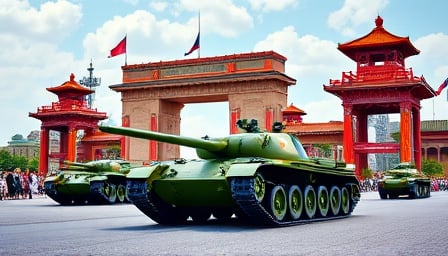The Surge in China’s Defense and Aerospace Sectors: A Critical Analysis
In a remarkable display of market dynamics, the defense and aerospace sectors in China have been on a relentless upward trajectory, capturing the attention of investors and analysts alike. The catalyst? A series of strategic military parades and the unveiling of cutting-edge military technologies. But beneath the surface, this surge raises critical questions about market sustainability, geopolitical implications, and the broader economic landscape.
A Market in Overdrive
On June 26, 2025, the defense and aerospace sectors continued their strong performance, with the defense ETF (512810) and the aerospace ETF (159227) leading the charge. The defense ETF saw a 1.9% increase, while the aerospace ETF notched a 2.75% rise, both setting new highs. This bullish trend was fueled by the anticipation of a grand military parade scheduled for September 3, showcasing China’s latest military advancements, including unmanned intelligent systems and hypersonic weapons.
The Role of North Navigation Control Technology Co Ltd
Amidst this fervor, North Navigation Control Technology Co Ltd, a company specializing in industrial computerized embroidery machines, quilters, and software for plate-making, found itself in the spotlight. While not directly involved in the defense sector, the company’s stock performance was influenced by the broader market trends. With a market cap of 176.6 billion CNH and a close price of 11.81 CNH on June 23, 2025, the company’s financial health and strategic positioning in the industrials sector were under scrutiny.
Critical Perspectives
The relentless rise in defense and aerospace stocks prompts a critical examination of market fundamentals. The Price Earnings Ratio of North Navigation Control Technology Co Ltd stood at an astonishing 193.68, signaling potential overvaluation concerns. This raises questions about the sustainability of the current market rally and the potential for a correction.
Moreover, the geopolitical implications of China’s military advancements and the global response cannot be ignored. The showcasing of new military technologies not only signifies China’s growing military capabilities but also its strategic intentions on the global stage. This development could lead to increased tensions and a potential arms race, with significant implications for global security and economic stability.
Conclusion
The surge in China’s defense and aerospace sectors, while indicative of technological advancements and strategic ambitions, also highlights the complexities of market dynamics and geopolitical tensions. As investors and analysts navigate this landscape, a critical and nuanced understanding of the underlying factors is essential. The case of North Navigation Control Technology Co Ltd serves as a reminder of the interconnectedness of industries and the broader economic and geopolitical context in which they operate.
